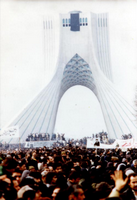The government of Iran struggled for decades to fit into the broader Middle East, and it has finally succeeded: It now sees its people principally as a source of instability rather than a source of legitimacy. Thirty years after the Revolution, the Iranian government has concluded that it is far better to anesthetize the population than mobilize it. It is a conclusion from which there is no turning back.
The Middle East has no shortage of formerly youthful revolutionary regimes that have slunk into middle age. In decades past, coups in Egypt, Iraq and Libya all tossed out corrupt Western-oriented monarchies in favor of populist military men who promised to return power to the people. These new leaders oversaw the creation of cadres of young people who took to the streets, filled new bureaucracies, and enthusiastically supported the new regime.
After a time, enthusiasms flagged as the charismatic young firebrands who had led coups and revolutions were replaced by colorless leaders. The press, which had been a reliable mobilizer of public sentiment, grew increasingly distrusted. The only people with increased power, it seems, were the internal intelligence agencies. No longer advancing the revolutionary vanguard, they were intent on reinforcing the status quo, and they did so with increasing efficiency.

